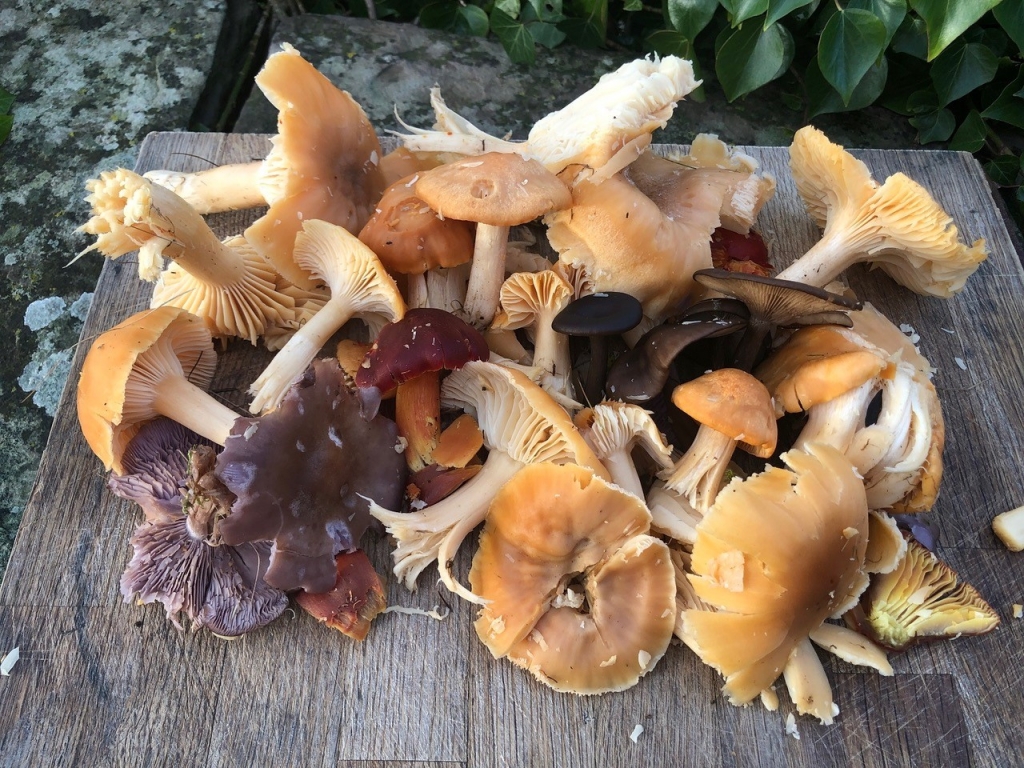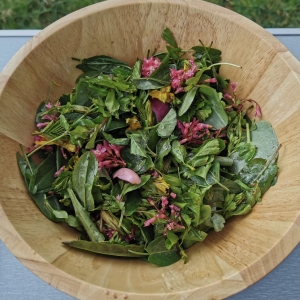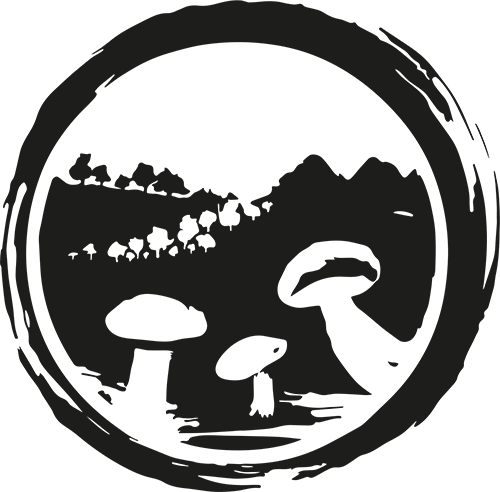What is Foraging?
Posted on 27th January 2021 
The simple answer is: Finding food from the wild.
The Wild Food UK Answer is: It’s a ‘skill for life’ and you never know when it’s going to come in handy. It’s a skill you can use almost anywhere when you are outside if you know what to look for.
At any time of year, a simple 5-minute walk can produce a lovely salad of sorrel, chickweed, pennywort and bittercress, and if you are sure of what you are picking there are wild mushrooms available all year round in the UK.

This salad is made up of our foraged finds including; Chickweed, Hawthorn buds, Common Sorrel, Lesser Celandine leaves, Ground Elder shoots, Oxeye Daisy leaves, Rowan buds, Magnolia petals, Forsythia flowers, Flowering Currant flowers and Dandelion flowers.
At the right time of year, there are also many edible wild flowers that not only taste good but make your food look spectacular. In Summer and Autumn, you can top up your fruit bowl with gooseberries, raspberries, blackberries, apples, damsons and pears plus plenty more. Hazelnuts, walnuts and sweet chestnuts are also readily available in Autumn.
When you know what to look for you might find that many of these things are growing in your own garden; even some of the gourmet mushrooms. Blewits and Fairy Ring Champignons are frequent garden invaders, and others like Wood Ears and Oyster mushrooms are easy to introduce.
Foraging has the very real benefits of exercise and fresh air and reducing your food bills, but most importantly it’s a fun way to learn about nature and introduce new flavours to your diet. This knowledge will make you an important person on any camping trip or walk through the woods.
Understanding the flora and fungi you are picking from is essential. There are many plants, fruits and even mushrooms that are very easy to recognise, but some do have poisonous and even deadly lookalikes, so a healthy dose of caution is essential.

A good forager does not damage their environment, they are a working part of it, helping spread seeds and spores as they forage. The role of the forager is to understand the food plants and fungal species they harvest, learn how they grow and how they interact with other things. These are things which are learnt naturally over time as you forage and observe how things change and grow.
It is important for a forager to know that some plants and fungi are deadly poisonous and that no risks should be taken with them.
Dress appropriately for the weather and environment, if you are going to pick sloes it is a good idea to take gloves and wear long sleeves. If you are going somewhere that you know wild animals such as deer, rabbits and badgers frequent, then boots are a good idea as they keep your ankles covered and help protect you from Ticks.
SEASONS
Spring
Some plants and mushrooms can be found throughout the year but each season has its own specific delights. There are always some mushrooms around at any time of year but in Spring we mainly look out for the young fresh shoots of the very tasty plants like Wild Garlic, plus the lovely sweet flowers that make all of our salads look good. Spring is the season of shoots.
There aren’t really any spring fruits to look for apart from cherries towards the end of march. Spring highlights include the St Georges Mushroom. Wild Garlic and Pignut.
Summer
Summer is a great season for the forager, lots of early plums, raspberries, cherries and gooseberries adorn the hedgerows. There are still lots of tasty plants, some of which, like ladies’ smock will be in flower and at their best edible and easiest to find stage. This is because of the flowers on the plant which are always the brightest and easiest to spot and identify. Summer is the season of flowers and Agaric Mushrooms around the UK, many of which are useful or edible.
Autumn
Autumn is easily the best season for mushrooms, with our fungal friends popping up everywhere in huge variety, it’s also when you’ll find our native nuts ripening and blackberries apples and pears at their most plentiful. When the trees leaves start to change colour you know Autumn has hit, and that’s when to get out looking for your wild mushroom treats. Hedgehog Fungus is a particularly good tasting and easy to identify mushroom from this season.
Autumn is the season of Fungus Fruits and nuts.
Winter
Winter is when we foragers have to look hardest for our finds. There are still some great mushrooms to look out for, and some hardy plants and roots, but you will struggle to find any fruit during our coldest season. The days are short too which gets in the way, and you need to spend an extra 5 minutes getting ready to make sure you are wrapped up warm enough. But if you can get out foraging this is the season where we find some of our most rewarding things like trooping funnels, scarlet elf cups, and blewit mushrooms.

DO’s and DON’TS
The first rule of foraging is to make sure you know that what you are eating is not going to poison you.
The second is to make sure that you are allowed to pick it, some places and species of plant and mushroom are protected and you should not forage from these.
If you are on private property you should always make sure you are allowed to pick what you find.
You should never pick more than half of what you find. Always leave some behind.
Make sure it is safe to pick. Don’t climb elder trees for example as they are not very strong and likely to snap.
Be careful around water, stay away from fast flowing water and banks near rivers, and do not pick from stagnant water.
Look out for stingy creatures such as wasps, hornets’ ants and bees.
Look for places where the plants look green and healthy and abundant.
Do not pick from corner posts or from the ground around trees where dogs are often walked.
Watch out for thorns and stinging nettles
Other Useful Tips
Never eat anything unless you are 100% sure what it is and that it is edible.
Everything picked from the ground should be washed before you eat it.
Many things picked from the wild, and almost all mushrooms should be cooked before they are eaten.
Any mouldy or discoloured bits of your finds should not be eaten
CARING FOR NATURE
It is very important that we care for nature as foragers as we need to look after our patches so that they continue to provide us fun for years to come.
While foraging take a minute to watch the insects and any other animals you see. You will find that they are all using the same plants as you for food and for their houses and to lay their eggs. Leave these behind if you notice any wildlife relying on them.
RARE SPECIES
There are many rare species of plants and mushrooms in the UK, and some that are fairly common in certain places but threatened or rare elsewhere, much like our native bluebells and orchids.
Protecting our native plants is important as some of them are found nowhere else int he world. They also all support our native insects and animals, whereas plants from other countries can harm them.
INVADERS
Some species are considered invasive. That means that they are not from the UK and have been brought here. When these plants and fungi get into the wild they can often threaten our own native flora and fauna. Some of these are edible though and so the forager can help to control them where they find them.
Three cornered Leek is one of these, now common in the UK this species was originally from the Mediterranean. It is a very tasty edible like a cross between Spring onions and Garlic. It is illegal to spread this plant in the wild in the UK so why not help control it by eating it!
Himalayan Balsam is one of the most successful invaders brought all the way from the Himalayas in south east Asia. It can now be found on almost every river bank in the UK and due to its exploding seed pods continues to invade places where our native riverside species such as wild garlic were once common. This plant is not as tasty as the Three-cornered Leek but it is also edible and abundant.
CREEPY CRAWLIES
Almost all creepy crawlies and other animals will do their best to avoid you if you give them the chance. Some you need to look out for though and help out or avoid if you can.
All of the plants, mushrooms and fruits we pick are also used by the animals and insects that live with them. This is one of the reasons we always leave plenty behind when we go foraging.
For example, a pile of logs in the woods will be home to numerous animals. Hedgehogs make their homes in these places, and stag beetles lay their grubs in the wood, so you shouldn’t disturb these places when foraging.
Always check leaves and plants before you pick them. Sometimes you will find lovely butterfly eggs or spiders egg sacks attached to them, and if so you should leave them where they are and not disturb the plant. The same goes for mushrooms, where if you find a maggoty patch leave them all behind, the maggots and flies are very important to the birds and other animals that feed off them. Even slugs and snails are important in this way, even if you don’t like our slimy friends, they are a favourite food of hedgehogs and badgers.
Fruit, berries and nuts are also great food for nature attracting animals from far around to the feast. This is not only good for the birds though as the plants and trees want them to eat their fruits so that they can then spread their seeds.
Lastly beware of ticks! These little creatures are not dangerous themselves, their bites are simply irritating and it can be disconcerting when you find them attached to you, but they do carry lymes disease in the UK and can pass it on to you if you are bitten.
